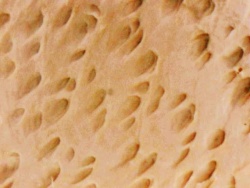Difference between revisions of "Crust leather"
| Line 37: | Line 37: | ||
==Crusting== | ==Crusting== | ||
| − | Crusting is part of the [[Leather production|tannery working steps for leather produciton]]. Crusting is when the hide is [[Leather production#Shaving|thinned]], [[tanning leather#retanned|retanned]] and [[ | + | Crusting is part of the [[Leather production|tannery working steps for leather produciton]]. Crusting is when the hide is [[Leather production#Shaving|thinned]], [[tanning leather#retanned|retanned]] and [[Oils & fats in the leather industry#Fatliquoring (regreasing)|regreased]]. Often a [[Leather dye - Leather color - Leather colour#Dyed leather|dye process]] is included in the crusting. Also part of the crusting is the [[Drying leather|drying]] and [[softening]]. |
| − | Crusting may include depending on the [[types of leather|type of leather]] | + | Crusting may include the following working steps depending on the [[types of leather|type of leather]]: |
* '''[[Split leather|Splitting]]''': The leather is split into one or more horizontal layers. | * '''[[Split leather|Splitting]]''': The leather is split into one or more horizontal layers. | ||
* '''[[Neutralising|neutralisation]]''': The pH of the leather is adjusted. | * '''[[Neutralising|neutralisation]]''': The pH of the leather is adjusted. | ||
Revision as of 21:51, 14 November 2016
Crust leather
Crustleder ist Leder, das nach der Gerbung getrocknet, aber noch nicht gefärbt ist. Bei chromgegerbten Ledern spricht man dann von "Chrom-Crust" oder bei pflanzlich gegerbten Ledern von "Pflanzen-Crust". Ein weiterer Begriff für "Crustleder" ist "Borke" oder "Borkeleder".
Crustleder wird nur selten weiterverarbeitet. Meist werden die Leder vor der Verarbeitung noch gefärbt und zugerichtet.
"Pflanzencrust" - "Chromcrust"
Pflanzliche Crustleder verarbeitet.
Unusual. Chrom-Crust weiterverarbeitet. Die Färbung ist so nicht ansprechend. Daher eher eine "Billig-Lösung".
Crusting
Crusting is part of the tannery working steps for leather produciton. Crusting is when the hide is thinned, retanned and regreased. Often a dye process is included in the crusting. Also part of the crusting is the drying and softening.
Crusting may include the following working steps depending on the type of leather:
- Splitting: The leather is split into one or more horizontal layers.
- neutralisation: The pH of the leather is adjusted.
- [[|Retanning: Additional tanning imparts properties.
- Dyeing: The leather is coloured in the drum.
- Fatliquoring: Fats and oils and waxes soften the leather fibres.
- Shaving: The leather is thinned using a machine which cuts leather fibres off the flesh side.
- Wetting: Leather has to be rehydrated depending on the following working steps.
- Sammying: Water is squeezed out the leather.
filling - heavy/dense chemicals that make the leather harder and heavier are added. stuffing - fats/oils and waxes are added between the fibres.
stripping - superficially fixed tannins are removed.
whitening - the colour of the leather is lightened.
fixation - all unbound chemicals are chemically bonded/trapped or removed from the leather
setting - area, grain flatness are imparted and excess water removed.
drying - the leather is dried to various moisture levels (commonly 14-25%).
conditioning - water is added to the leather to a level of 18-28%.
softening - physical softening of the leather by separating the leather fibres.
buffing - abrasion of the surfaces of the leather to reduce nap or grain defects.
Additional information













 a kotori web solution
a kotori web solution